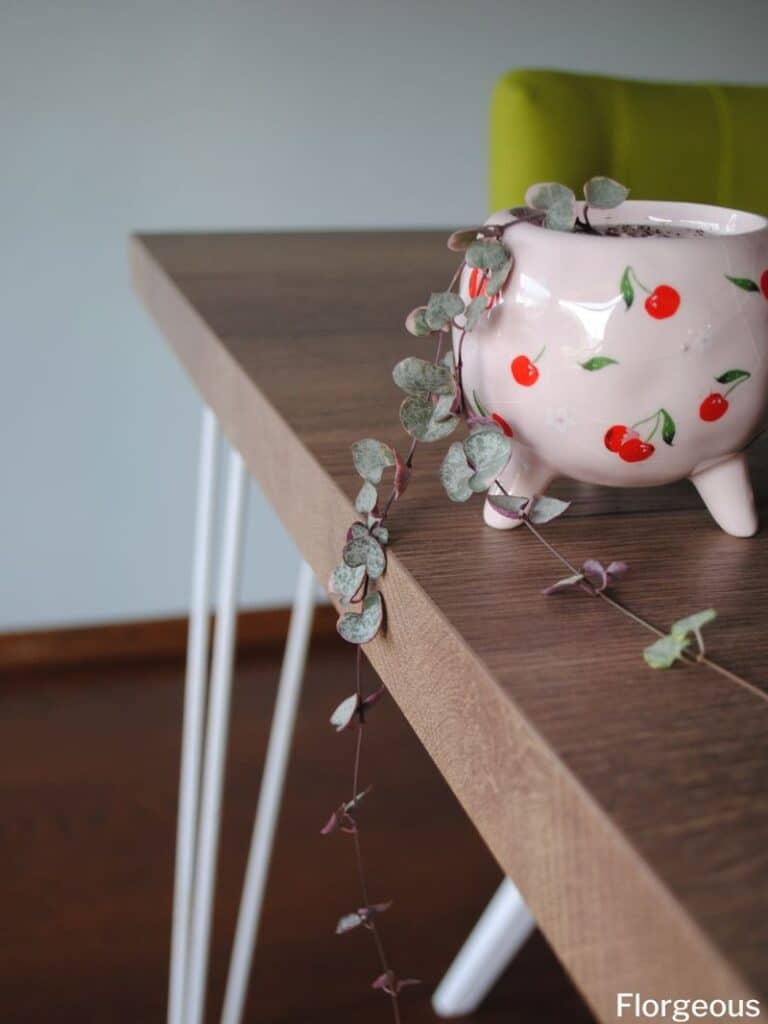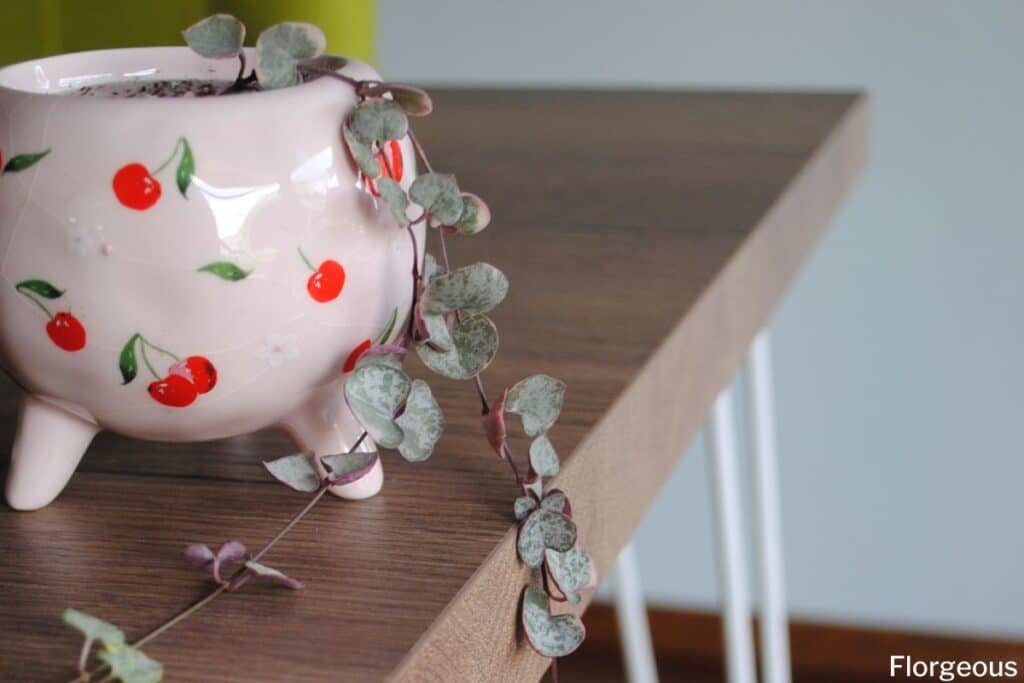If you’re looking for a delicate, charming indoor vine plant, the variegated string of hearts is perfect for you. This easy-to-care-for plant has trailing vines covered in heart-shaped leaves that are speckled with white markings.
With the right care, your variegated string of hearts can thrive and add some natural beauty to your home or office.
Read on to learn how to grow and care for this lovely little plant.
Plant Facts
| Scientific name | Ceropegia woodii variegata “String of Hearts” |
| Common names | Variegated string of hearts, rosary vine, chain of hearts, sweetheart vine, collar of hearts |
| Family | Apocynaceae |
| Plant Type | Succulent houseplant |
| Height and Width | Up to 2” tall, 6-13’ long |
| Origin | South Africa, Swaziland, and Zimbabwe |
| Flower colors | None |
| Foliage color | Pale green and pink |
| Sun Exposure | Bright indirect light |
| Soil Type & pH | Well-drained cacti mix |
| Special features | Trailing succulent houseplant, attractive pink foliage, great for containers |
How to Grow Variegated String of Hearts
Also known as Rosary Vine or Chain of Hearts, the Variegated String of Hearts (Ceropegia woodii) is a beautiful and unique plant that is easy to care for. Native to South Africa, this succulent has long, slender trailing stems that are covered in small, heart-shaped leaves.
The leaves are usually green with white or silver variegation, although they can also be entirely light pink or purple. The Variegated String of Hearts is a fast-growing plant, and it can quickly become overgrown if not trimmed regularly. However, with a little care, it can make a stunning addition to any indoor space.
Propagation
To grow a Variegated String of Hearts, start with a stem cutting that is at least four inches long. Place the cutting in a glass of water and wait for it to develop roots (this can take up to a few weeks).
Once the roots have grown, plant the cutting in a well-draining potting mix. Place it in a bright location and warm temperatures. Water the heart plant regularly, allowing the soil to dry out completely between waterings. Trim the stems regularly to keep the plant from getting too leggy. With a little care, your Variegated String of Hearts will be growing long and proud in no time!
Soil
The plant prefers a well-draining mix and should be allowed to dry out completely between waterings. Keep the soil slightly moist, but avoid waterlogged soil.
In terms of soil type, the best option for the variegated string of hearts cacti mix is a well-draining cactus or succulent mix. In many cases, even coarse sand or gravel will work.
This type of soil will help to prevent the roots from rotting, which can occur if the plant is overwatered. The mix should also contain some perlite or sand to improve drainage.
Pruning
Propagating variegated string of hearts from stem cuttings is easy and doesn’t require much care. However, the mother plant will become leggy over time and will need to be pruned back to encourage new growth.
When pruning, it is important to use sharp, sterile scissors and to make clean cuts just above a leaf node. New growth will emerge from the leaf nodes, so pruning back to them will encourage full, bushy growth. Once the plant has been pruned, it can be fertilized with a half-strength liquid fertilizer.
Repotting and Transplanting
The variegated string of hearts, also known as the Rosary vine or weeping fig, is a beautiful and easy-to-care-for houseplant. While it can tolerate some neglect, the plant will thrive if it is reported every two to three years. Transplanting is also a good opportunity to propagate string of hearts by taking stem cuttings.
Here’s how to repot and transplant a variegated string of hearts.
First, choose a pot that is only slightly larger than the current pot. Add fresh regular potting soil to the new pot, and then gently remove the plant from its current pot. Be careful not to damage the roots. Place the plant in the new pot, and fill it around with a potting mix. Water well and place in a bright, but not direct, light.

Variegated String of Hearts Care Guide
The variegated string of hearts (Ceropegia linearis variegata) is a beautiful, easy-to-care-for houseplant that is native to South Africa. It gets its name from its heart-shaped leaves, which are absolutely breathtaking to behold.
With a little care, the variegated string of hearts makes a lovely addition to any indoor space. Here are some tips on how to care for string of hearts:
Water
When watering, allow the soil to dry out completely between waterings. The best way to water this trailing succulent is to use the soak and dry method; water thoroughly until water runs out of the drainage holes, then allow the plant to dry out completely before watering again.
Avoid leaving the delicate vines sitting in wet soil, as this can cause root rot. If you are unsure whether or not to water your plant, it is better to err on the side of underwatering. Your container should have at least one drainage hole, if not more, so that excess water can escape. This is essential even if you are using a well-draining soil type, like pumice or cactus soil mix.
Sunlight
This plant is easy to care for and can tolerate low light levels, making it ideal for beginners. However, it will produce more flowers and leaves if it receives enough bright light. The ideal amount of direct sunlight for this plant is four to six hours per day. It prefers bright indirect sunlight and will get enough light from a north facing window, in most cases.
Remember that insufficient light can affect its growth, so find the right balance for optimal health. If you live in an area with hot summers, it’s best to place the plant in a spot where it will receive morning sun and afternoon shade. This will help to prevent the leaves from getting sunburned and maintain their dark green color.
Temperature and Humidity
Unlike many other succulents, this plant does not prefer dry, sunny conditions. Instead, it prefers a humid environment with moderate temperatures. The ideal temperature range for the Variegated String of Hearts is between 60 and 80 degrees Fahrenheit.
This succulent plant will also do well in an environment with high humidity, such as a bathroom or kitchen. You can even use a humidifier to ensure the leaves get the moisture they need without providing too much water to the plant’s sensitive tubers.
Again, it is important to make sure that the soil drains well, as the plant will not tolerate extreme temperature fluctuations. During early summer, pay attention to maintaining the right conditions for your plant’s well-being.
Fertilizer
String of Hearts is a relatively easy plant to care for, but it does require regular fertilization to maintain its lush foliage. A balanced liquid fertilizer should be applied every two weeks during the growing season. Be sure to dilute the fertilizer to half strength to avoid burning the delicate leaves.
The Variegated String of Hearts plant is a fast-growing plant, so it will quickly use up the nutrients in the soil. For best results, use a high-quality fertilizer that contains all the essential nutrients needed for optimal growth.
You may want to use a fertilizer that is designed specifically for use on a succulent plant – one that is meant for cacti and similar plants growing in hanging baskets is a good idea.
Pest and diseases
The Variegated String of Hearts is a beautiful and popular houseplant that is easy to care for. However, like all plants, it can be susceptible to pest infestations. The three most common pests of the variegated string of hearts are mealybugs, aphids, spider mites, and whiteflies. Luckily, all three of these pests can be controlled with regular applications of insecticidal soap or horticultural oil.
This plant is not prone to many diseases, but the most common one is root rot.
If you notice any of these problems with your plant, it is important to take action immediately. Remove any affected leaves or stems and increase air circulation around the plant. This can address the vast majority of disease and pest problems.
Mealybugs
Mealybugs are small, fuzzy creatures that feed on plant juices, causing the leaves to yellow and wilt.
Mealybugs are especially fond of string of heart plants, and they can quickly kill a plant if they are not removed. To control mealybugs, it is important to regularly inspect your plants for signs of infestation. Mealybugs can be killed with various insecticides, but it is important to choose a safe product on a string of heart plants.
Aphids
Aphids are small, sap-sucking insects that can cause serious damage to a string of heart plants. These pests are often found in large numbers on the undersides of leaves, where they feed on plant sap.
Aphids can weaken plants and stunt their growth, and they can also spread disease. If you suspect that your string of heart plants have aphids, you can do a few things to get rid of them. One option is to spray the plant with rubbing alcohol. This will kill the aphids on contact. You can also try using an insecticidal soap or neem oil.
Spider Mites
Spider mites are smaller than mealybugs and spin webs as they feed, damaging the plant’s leaves. Both mealybugs and spider mites can be controlled with regular applications of insecticidal soap or horticultural oil.
Whiteflies
Whiteflies are small winged insects that suck plant juices and excrete a sticky substance called honeydew. Honeydew can attract ants and other pests, so it’s important to control whiteflies as soon as they’re noticed.
There are a few things that you can do to help get rid of whiteflies on your string of hearts plants. First, make sure to keep your trailing vines healthy and free from stress. This will make them less attractive to whiteflies. Second, try using traps or sticky barriers to physically remove the pests from your plants.
Root Rot
Root rot is one of the most common problems with this plant. It is caused by too much water and can lead to the death of the plant.
Root rot is a serious problem that can affect the string of heart plants. The first symptom of root rot is usually wilting or yellowing leaves. This is followed by the plant’s roots turning brown and mushy.
If left untreated, root rot will eventually kill the plant. The best way to prevent root rot is to plant a string of hearts in well-draining soil. If the plant does develop root rot, it is important to remove it from the soil immediately and replant it in fresh soil.
Common Varieties and Cultivars
There are many different cultivars of String of Hearts available, each with its own unique leaf pattern. While the Variegated String of Hearts Plant is the most common, there are plenty of other String of Hearts plants to choose from as well.
Some of the most popular cultivars include ‘Mona Lisa’, ‘String of Hearts Silver Glory’, ‘String of Spades,’ and ‘Confetti’. Regardless of the cultivar, all variegated string of heart plants require well-draining soil and bright, indirect light.
Plant lovers everywhere are sure to find a String of Hearts that suit them well!
FAQs
How much sun does variegated string of hearts need?
Variegated String of Hearts (Ceropegia woodii variegata) prefers bright, indirect light. It thrives in a location with plenty of natural light but should be protected from too much sunlight, which can scorch its delicate foliage. Providing filtered sunlight or partial shade is ideal for this plant.
Why is variegated string of hearts so expensive?
Variegated String of Hearts can be more expensive than the non-variegated variety due to its unique and visually appealing foliage.
Is the variegated string of hearts toxic?
No, variegated String of Hearts is not considered toxic to humans or pets. However, ingesting large quantities of any plant material can still cause digestive discomfort, so it’s best to keep it out of reach of curious pets and children.
Are all variegated string of hearts pink?
Not all variegated String of Hearts have pink coloring. While some varieties may exhibit pink or reddish hues in their foliage, others may display shades of cream, white, or even silver along with dark green. The exact coloration can vary depending on factors such as light intensity, genetics, and environmental conditions.
Conclusion
If you’re looking for a low-maintenance, easy to grow houseplant that will add some color and life to any room in your home, the variegated string of hearts is a great option. With just a little bit of TLC, this plant can thrive for years.
Follow our tips on how to care for your variegated string of hearts, and enjoy watching it grow! Have you tried growing a variegated string of hearts? What tips would you add, fellow plant enthusiasts?







